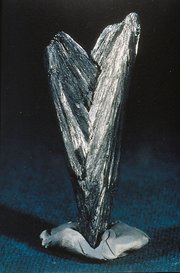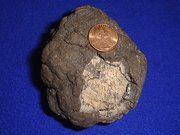|
|||||
| General | |||||
|---|---|---|---|---|---|
| Name, Symbol, Number | manganese, Mn, 25 | ||||
| Chemical series | transition metals | ||||
| Group, Period, Block | 7 , 4 , d | ||||
| Density, Hardness | 7470 kg/m3, 6.0 | ||||
| Appearance | silvery
metallic |
||||
| Atomic properties | |||||
| Atomic weight | 54.938049 amu | ||||
| Atomic radius (calc.) | 140 (161) pm | ||||
| Covalent radius | 139 pm | ||||
| van der Waals radius | n/a pm | ||||
| Electron configuration | [Ar]3d54s2 | ||||
| e- 's per energy level | 2, 8,13,2 | ||||
| Oxidation states (Oxide) | 7,6,4,2,3 (strong acid) | ||||
| Crystal structure | cubic body centered | ||||
| Physical properties | |||||
| State of matter | solid (usually nonmagnetic) | ||||
| Melting point | 1517 K (2271 °F) | ||||
| Boiling point | 2235 K (3564 °F) | ||||
| Molar volume | 7.35 ×10-6 m3/mol | ||||
| Heat of vaporization | 226 kJ/mol | ||||
| Heat of fusion | 12.05 kJ/mol | ||||
| Vapor pressure | 121 Pa at 1517 K | ||||
| Velocity of sound | 5150 m/s at 293.15 K | ||||
| Miscellaneous | |||||
| Electronegativity | 1.55 (Pauling scale) | ||||
| Specific heat capacity | 480 J/(kg*K) | ||||
| Electrical conductivity | 0.695 106/(m·ohm) | ||||
| Thermal conductivity | 7.82 W/(m*K) | ||||
| 1st ionization potential | 717.3 kJ/mol | ||||
| 2nd ionization potential | 1509 kJ/mol | ||||
| 3rd ionization potential | 3248 kJ/mol | ||||
| 4th ionization potential | 4940 kJ/mol | ||||
| 5th ionization potential | 6990 kJ/mol | ||||
| 6th ionization potential | 9220 kJ/mol | ||||
| 7th ionization potential | 11500 kJ/mol | ||||
| SI units & STP are used except where noted. | |||||
Manganese is a chemical element in the periodic table that has the symbol Mn and atomic number 25.
|
|
Notable characteristics
Manganese is a gray-white metal, resembling iron. It is a hard metal and is very brittle, fusible with difficulty, but easily oxidized. Manganese metal is ferromagnetic only after special treatment.
The most common oxidation states of manganese are +2, +3, +4, +6 and +7, though oxidation states from +1 to +7 are observed. Mn2+ often competes with Mg2+ in biological systems, and manganese compounds where manganese is in oxidation state +7 are powerful oxidizing agents.
Applications

Manganese is essential to iron and steel production by virtue of its sulfur-fixing, deoxidizing, and alloying properties. Steelmaking, including its ironmaking component, has accounted for most manganese demand, presently in the range of 85% to 90% of the total demand. Among a variety of other uses, manganese is a key component of low-cost stainless steel formulations and certain widely used aluminium alloys. Manganese (IV) oxide is used in the original type of dry cell battery. Manganese dioxide is also used as a catalyst. Manganese is used to decolorize glass (removing the greenish tinge that presence of iron produces) and, in higher concentration, make violet-colored glass. Manganese oxide is a brown pigment that can be used to make paint and is a component of natural umber. Potassium permanganate is a potent oxidizer and used in chemistry and in medicine as disinfectant agent.
The overall level and nature of manganese use in the United States is expected to remain about the same in the near term. No practical technologies exist for replacing manganese with other materials or for using domestic deposits or other accumulations to reduce the complete dependence of the United States on other countries for manganese ore.
Substitutes: Manganese has no satisfactory substitute in its major applications.
History
Manganese was in use in prehistoric times. Paints that were pigmented with manganese dioxide can be traced back 17,000 years. The Egyptians and Romans used manganese compounds in glass-making, to either remove color from glass or add color to it. Manganese can be found in the iron ores used by the Spartans. Some speculate that the exceptional hardness of Spartan steels derives from the inadvertent production of an iron-manganese alloy.
In the 17th century, the German chemist Johann Glauber (although some people believe that it was discovered by Ignites Kaim in 1770) first produced permanganate, a useful laboratory reagent. By the mid 18th century, manganese oxide was in use in the manufacture of chlorine. The Swedish chemist Scheele was the first to recognize that manganese was an element, and his colleague, Johan Gottlieb Gahn, isolated the pure element in 1774 by reduction of the dioxide with carbon. Around the beginning of the 19th century, scientists began exploring the use of manganese in steelmaking, with patents being granted for its use at the time. In 1816, it was noted that adding manganese to iron made it harder, without making it any more brittle.
Biological role
Manganese is an essential trace nutrient in all forms of life.
The classes of enzymes that have manganese cofactors are very broad and include such classes as oxidoreductases, transferases, hydrolases, lyases, isomerases, ligases, lectins, and integrins. The best known manganese containing polypeptides may be arginase, Mn containing superoxide dismutase, and the diphtheria toxin.

Land-based resources are large but irregularly distributed; those of the United States are very low grade and have potentially high extraction costs. South Africa and Ukraine account for more than 80% of the world's identified resources; South Africa accounts for more than 80% of the total exclusive of China and Ukraine.
US Import Sources (1998-2001): Manganese ore: Gabon, 70%; South Africa, 10%; Australia, 9%; Mexico, 5%; and other, 6%. Ferromanganese: South Africa, 47%; France, 22%; Mexico, 8%; Australia, 8%; and other, 15%. Manganese contained in all manganese imports: South Africa, 31%; Gabon, 21%; Australia, 13%; Mexico, 8%; and other, 27%.
Manganese is mined in Burkina Faso.
Vast quantities of manganese exist in manganese nodules on the ocean floor. Attempts to find economically viable methods of harvesting manganese nodules were abandoned in the 1970s.
Compounds
Potassium permanganate, also called Condy's crystals, is a commonly used laboratory reagent because of its oxidizing properties and finds use as a topical medicine (for example, in the treatment of fish diseases).
Manganese dioxide is used in dry cells, and can be used to decolorize glass that is polluted by trace amounts of iron. Manganese compounds can color glass an amethyst color, and is responsible for the color of true amethyst. Manganese dioxide is also used in the manufacture of oxygen and chlorine, and in drying black paints.
Isotopes
Naturally occurring manganese is composed of 1 stable isotope; 55-Mn. 18 radioisotopes have been characterized with the most stable being 53-Mn with a half-life of 3.7 million years, 54-Mn with a half-life of 312.3 days, and 52-Mn with a half-life of 5.591 days. All of the remaining radioactive isotopes have half lives that are less than 3 hours and the majority of these have half lives that are less than 1 minute. This element also has 3 meta states.
Manganese is part of the iron group of elements which are thought to be synthesized in large stars shortly before supernova explosion. Manganese-53 decays to 53Cr with a half-life of 3.7 million years. Because of its relatively short half-life, 53Mn is an extinct radionuclide. Manganese isotopic contents are typically combined with chromium isotopic contents and have found application in isotope geology. Mn-Cr isotopic ratios reinforce the evidence from 26Al and 107Pd for the early history of the solar system. Variations in 53Cr/52Cr and Mn/Cr ratios from several meteorites indicate an initial 53Mn/55Mn ratio that suggests Mn-Cr isotopic systematics must result from in-situ decay of 53Mn in differentiated planetary bodies. Hence 53Mn provides additional evidence for nucleosynthetic processes immediately before coalescence of the solar system.
The isotopes of manganese range in atomic weight from 46 amu (46-Mn) to 65 amu (65-Mn). The primary decay mode before the most abundant stable isotope, 55-Mn, is electron capture and the primary mode after is beta decay.
Precautions
Manganese in excess is toxic. Exposure to manganese dusts and fumes should not exceed the ceiling value of 5 mg/m3 for even short periods because of its toxicity level.
Acidic permanganate solutions will oxidize any organic material they come into contact with. The oxidation process can generate enough heat to ignite some organic substances.
Parkinson's Disease has been linked to manganese exposure and the welding industry especially. Scientists have reported that welders studied had an average of the onset of Parkinson's Disease 15 years prior to the rest of the general population. Listed on the Hazardous Substance List, manganese is regulated by OSHA due to its high level of toxicity.
References
- Los Alamos National Laboratory – Manganese (http://periodic.lanl.gov/elements/25.html)
External links
- EnvironmentalChemistry.com – Manganese (http://environmentalchemistry.com/yogi/periodic/Mn.html)
- International Manganese Institute (http://www.manganese.org)
- Parkinson's Disease and Manganese (http://www.onlinelawyersource.com/manganese/manganese_parkinsons.html)

